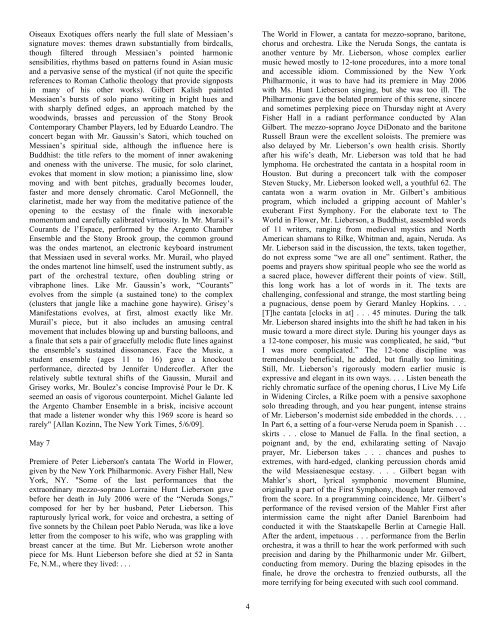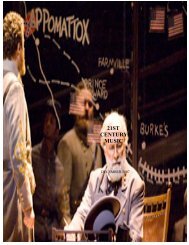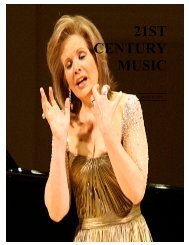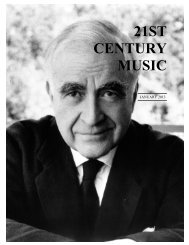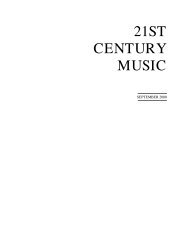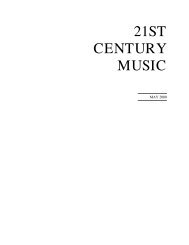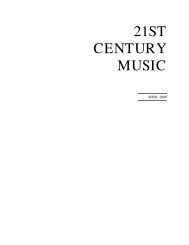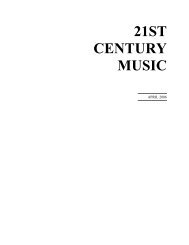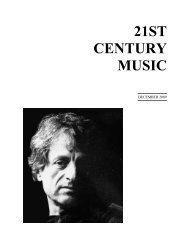Create successful ePaper yourself
Turn your PDF publications into a flip-book with our unique Google optimized e-Paper software.
Oiseaux Exotiques offers nearly the full slate of Messiaen’s<br />
signature moves: themes drawn substantially from birdcalls,<br />
though filtered through Messiaen’s pointed harmonic<br />
sensibilities, rhythms based on patterns found in Asian music<br />
and a pervasive sense of the mystical (if not quite the specific<br />
references to Roman Catholic theology that provide signposts<br />
in many of his other works). Gilbert Kalish painted<br />
Messiaen’s bursts of solo piano writing in bright hues and<br />
with sharply defined edges, an approach matched by the<br />
woodwinds, brasses and percussion of the Stony Brook<br />
Contemporary Chamber Players, led by Eduardo Leandro. The<br />
concert began with Mr. Gaussin’s Satori, which touched on<br />
Messiaen’s spiritual side, although the influence here is<br />
Buddhist: the title refers to the moment of inner awakening<br />
and oneness with the universe. The music, for solo clarinet,<br />
evokes that moment in slow motion; a pianissimo line, slow<br />
moving and with bent pitches, gradually becomes louder,<br />
faster and more densely chromatic. Carol McGonnell, the<br />
clarinetist, made her way from the meditative patience of the<br />
opening to the ecstasy of the finale with inexorable<br />
momentum and carefully calibrated virtuosity. In Mr. Murail’s<br />
Courants de l’Espace, performed by the Argento Chamber<br />
Ensemble and the Stony Brook group, the common ground<br />
was the ondes martenot, an electronic keyboard instrument<br />
that Messiaen used in several works. Mr. Murail, who played<br />
the ondes martenot line himself, used the instrument subtly, as<br />
part of the orchestral texture, often doubling string or<br />
vibraphone lines. Like Mr. Gaussin’s work, “Courants”<br />
evolves from the simple (a sustained tone) to the complex<br />
(clusters that jangle like a machine gone haywire). Grisey’s<br />
Manifestations evolves, at first, almost exactly like Mr.<br />
Murail’s piece, but it also includes an amusing central<br />
movement that includes blowing up and bursting balloons, and<br />
a finale that sets a pair of gracefully melodic flute lines against<br />
the ensemble’s sustained dissonances. Face the <strong>Music</strong>, a<br />
student ensemble (ages 11 to 16) gave a knockout<br />
performance, directed by Jennifer Undercofler. After the<br />
relatively subtle textural shifts of the Gaussin, Murail and<br />
Grisey works, Mr. Boulez’s concise Improvisé Pour le Dr. K<br />
seemed an oasis of vigorous counterpoint. Michel Galante led<br />
the Argento Chamber Ensemble in a brisk, incisive account<br />
that made a listener wonder why this 1969 score is heard so<br />
rarely" [Allan Kozinn, The New York Times, 5/6/09].<br />
May 7<br />
Premiere of Peter Lieberson's cantata The World in Flower,<br />
given by the New York Philharmonic. Avery Fisher Hall, New<br />
York, NY. "Some of the last performances that the<br />
extraordinary mezzo-soprano Lorraine Hunt Lieberson gave<br />
before her death in <strong>July</strong> 2006 were of the “Neruda Songs,”<br />
composed for her by her husband, Peter Lieberson. This<br />
rapturously lyrical work, for voice and orchestra, a setting of<br />
five sonnets by the Chilean poet Pablo Neruda, was like a love<br />
letter from the composer to his wife, who was grappling with<br />
breast cancer at the time. But Mr. Lieberson wrote another<br />
piece for Ms. Hunt Lieberson before she died at 52 in Santa<br />
Fe, N.M., where they lived: . . .<br />
The World in Flower, a cantata for mezzo-soprano, baritone,<br />
chorus and orchestra. Like the Neruda Songs, the cantata is<br />
another venture by Mr. Lieberson, whose complex earlier<br />
music hewed mostly to 12-tone procedures, into a more tonal<br />
and accessible idiom. Commissioned by the New York<br />
Philharmonic, it was to have had its premiere in May 2006<br />
with Ms. Hunt Lieberson singing, but she was too ill. The<br />
Philharmonic gave the belated premiere of this serene, sincere<br />
and sometimes perplexing piece on Thursday night at Avery<br />
Fisher Hall in a radiant performance conducted by Alan<br />
Gilbert. The mezzo-soprano Joyce DiDonato and the baritone<br />
Russell Braun were the excellent soloists. The premiere was<br />
also delayed by Mr. Lieberson’s own health crisis. Shortly<br />
after his wife’s death, Mr. Lieberson was told that he had<br />
lymphoma. He orchestrated the cantata in a hospital room in<br />
Houston. But during a preconcert talk with the composer<br />
Steven Stucky, Mr. Lieberson looked well, a youthful 62. The<br />
cantata won a warm ovation in Mr. Gilbert’s ambitious<br />
program, which included a gripping account of Mahler’s<br />
exuberant First Symphony. For the elaborate text to The<br />
World in Flower, Mr. Lieberson, a Buddhist, assembled words<br />
of 11 writers, ranging from medieval mystics and North<br />
American shamans to Rilke, Whitman and, again, Neruda. As<br />
Mr. Lieberson said in the discussion, the texts, taken together,<br />
do not express some “we are all one” sentiment. Rather, the<br />
poems and prayers show spiritual people who see the world as<br />
a sacred place, however different their points of view. Still,<br />
this long work has a lot of words in it. The texts are<br />
challenging, confessional and strange, the most startling being<br />
a pugnacious, dense poem by Gerard Manley Hopkins. . . .<br />
[T]he cantata [clocks in at] . . . 45 minutes. During the talk<br />
Mr. Lieberson shared insights into the shift he had taken in his<br />
music toward a more direct style. During his younger days as<br />
a 12-tone composer, his music was complicated, he said, “but<br />
I was more complicated.” The 12-tone discipline was<br />
tremendously beneficial, he added, but finally too limiting.<br />
Still, Mr. Lieberson’s rigorously modern earlier music is<br />
expressive and elegant in its own ways. . . . Listen beneath the<br />
richly chromatic surface of the opening chorus, I Live My Life<br />
in Widening Circles, a Rilke poem with a pensive saxophone<br />
solo threading through, and you hear pungent, intense strains<br />
of Mr. Lieberson’s modernist side embedded in the chords. . . .<br />
In Part 6, a setting of a four-verse Neruda poem in Spanish . . .<br />
skirts . . . close to Manuel de Falla. In the final section, a<br />
poignant and, by the end, exhilarating setting of Navajo<br />
prayer, Mr. Lieberson takes . . . chances and pushes to<br />
extremes, with hard-edged, clanking percussion chords amid<br />
the wild Messiaenesque ecstasy. . . . Gilbert began with<br />
Mahler’s short, lyrical symphonic movement Blumine,<br />
originally a part of the First Symphony, though later removed<br />
from the score. In a programming coincidence, Mr. Gilbert’s<br />
performance of the revised version of the Mahler First after<br />
intermission came the night after Daniel Barenboim had<br />
conducted it with the Staatskapelle Berlin at Carnegie Hall.<br />
After the ardent, impetuous . . . performance from the Berlin<br />
orchestra, it was a thrill to hear the work performed with such<br />
precision and daring by the Philharmonic under Mr. Gilbert,<br />
conducting from memory. During the blazing episodes in the<br />
finale, he drove the orchestra to frenzied outbursts, all the<br />
more terrifying for being executed with such cool command.<br />
4


